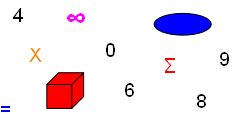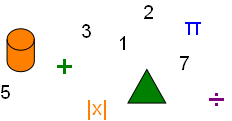



The Determinant of a 4×4 Matrix


To understand how to produce the determinant of a 4×4 matrix it is first necessary to understand how to produce the determinant of a 3×3 matrix. The reason; determinants of 4×4 matrices involve eliminating a row and column of the matrix, evaluating the remaining 3×3 matrix for its minors and cofactors and then expanding the cofactors to produce the determinant.
Matrix A with Order 4×4
4×4 | Column 1 | Column 2 | Column 3 | Column 4 |
Row 1: | 1+ | −2− | 3+ | 0− |
Row 2: | −1− | 1+ | 0− | 2+ |
Row 3: | 0+ | 2− | 0+ | 3− |
Row 4: | 3− | 4+ | 0− | 2+ |
Choose a13 of column 3. This makes less work to determine the minors and cofactors as the remaining array elements of column 3 have zero values. This means the multiplication by their cofactor will be zero and the only array element to consider is a13. We need only determine the cofactor for one array element instead of 4.
If the determinant of the matrix were to be produced by using the array elements of row 1 instead of column 3, or based upon an array element other than a13, this would require greater effort, however would produce the same determinant value.
Now delete the first row and the third column and write the 3×3 matrix …
Matrix a13 with Order 3×3
−1 | 1 | 2 |
0 | 2 | 3 |
3 | 4 | 2 |
Next create the determinant based on column 3 array elements of matrix A …
Matrix a13
−1 | 1 | 2 |
0 | 2 | 3 |
3 | 4 | 2 |
M(A) = (−1) ×
2 | 3 |
4 | 2 |
+
Matrix a13
−1 | 1 | 2 |
0 | 2 | 3 |
3 | 4 | 2 |
0 ×
1 | 2 |
4 | 2 |
+
Matrix a13
−1 | 1 | 2 |
0 | 2 | 3 |
3 | 4 | 2 |
3 ×
1 | 2 |
2 | 3 |
M(A) = ( −1 × [ 2 (2) − 4 (3) ] ) + 0 + ( 3 × [ 1 (3) − 2 (2) ] )
M(A) = 8 + 0 + −3 = 5
If the original Matrix A had other column 3 array elements that were greater than 0 we would have created additional 3×3 matrices for those elements and produced a minor, Mij, for those column 3 array elements. These additional minors would have contributed to the coefficient, Cij, and finally the determinant.
C13 = pattern sign a13 × (5) = (+) (5) = 5
det(A) = a13 × C13 = 3 (5) = 15
Copyright © DigitMath.com
All Rights Reserved.